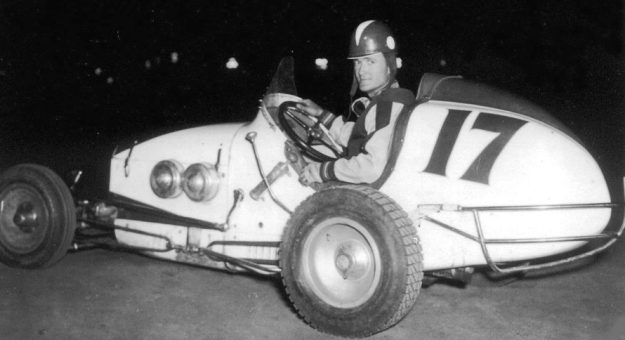An article from the Aug. 8, 1951, issue of National Speed Sport News opened with these words, “Houston, Texas, Aug. 2. A great little guy was laid to rest here Thursday afternoon with hundreds of auto racing men and fans on hand.”
The great little guy was Cecil Green, remembered as one of three drivers killed in AAA competition on a dreadful 1951 afternoon immortalized as “Black Sunday.” Green and Bill Mackey perished during consecutive qualifying runs at Winchester (Ind.) Speedway, while Walt Brown died at Pennsylvania’s Williams Grove Speedway.
There’s more to Green’s legacy than a racer trapped in an eerie set of deadly circumstances. He was a determined, aggressive driver who fought his way to the top of his sport, making it all the way to Indianapolis.
Green was born Judge Cecil Holt on July 30, 1919. The reasons he changed his surname to Green, yet kept his un-race driver sounding given name, are unknown. Perhaps it was because he was underage when he started racing motorcycles and jalopies near his Dallas, Texas, home in 1938.
In 1941, Green moved from those humble beginnings to midgets, but World War II interrupted his escalating career. He enlisted in the Army and earned two Purple Hearts while surviving several brutal battles.
When racing resumed in 1946, Green returned to the midgets, running first with the Gulf Coast Racing Ass’n and then joining forces with Oklahoma City’s M.A. Walker and his potent midget team. Accompanied by teammate Jud Larson, he raced seven days a week on bullrings and county fair tracks scattered throughout Texas, California, Oklahoma, Michigan and Ohio.
Green won everywhere he raced. During one stretch, from 1948-50, he won 34 midget features. When asked by a reporter how they managed to do things like wash their clothes with all the traveling, Green responded, “We don’t, we just buy new ones.”
Those were crazy, hectic days, but Green loved it. Racing drove him and shaped his life. That passion combined with obvious talent gained him a shot at the Indianapolis 500. Walker bought a new Kurtis-Kraft 3000, hired Offy engine master “Chickie” Hirashima as chief mechanic, enlisted financial help from fellow Oklahoman Jack Zink and took Green to the speedway in 1950.
Tony Bettenhausen mentored Green and he responded with the second-fastest qualifying speed and a fine fourth-place finish. After Indianapolis, Green campaigned the powder-blue Walker-Kurtis on the remainder of the Championship Trial, finishing fourth in the AAA standings.
Green returned to the Championship Trail with Walker the following year. He qualified 10th at Indianapolis, led the race early and ran with the leaders until a broken rod put him out after 80 laps.
There’s a saying at Indianapolis, “If you can lead it; you can win it.” Most observers agreed Cecil Green had what it took to win the 500. But time ran out. Following the 1951 500, Green finished second at The Milwaukee Mile, third at Langhorne (Pa.) Speedway and third at Darlington (S.C.) Raceway.
The next race was July 29 at Williams Grove. But it wasn’t a points-paying event, so Walker sent his car back to Oklahoma City for an engine rebuild. Without a ride, Green shopped around for a sprint car for the Winchester event being held the same weekend. He found a good one.
Troy Ruttman chose to run at Williams Grove, leaving an open seat in J.C. Agajanian’s famed No. 98jr. Aggie didn’t want Green to drive the car. Green’s aggressive style troubled him. However, Ruttman’s father, who was the mechanic on No. 98jr, believed Green possessed untapped potential and only needed a good car under him to prove it. Aggie acquiesced.
What happened at Winchester has never been completely understood. Many believed that earlier qualifiers ran low and scattered gravel and dirt into the groove.
Green lost control, impacted the guardrail and tumbled over it. When rescuers reached him, he was barely alive. They rushed him to Winchester’s Randolph County Hospital, but he died en route.
